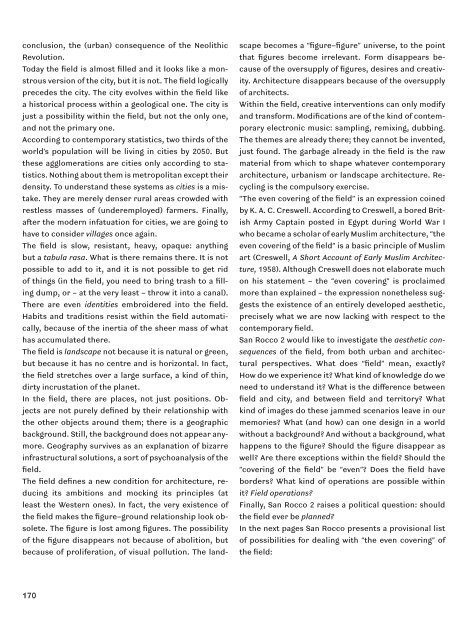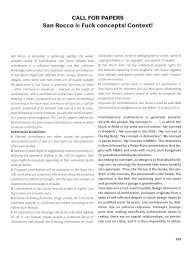CALL FOR PAPERS San Rocco 2: The Even Covering of the Field
CALL FOR PAPERS San Rocco 2: The Even Covering of the Field
CALL FOR PAPERS San Rocco 2: The Even Covering of the Field
Create successful ePaper yourself
Turn your PDF publications into a flip-book with our unique Google optimized e-Paper software.
conclusion, <strong>the</strong> (urban) consequence <strong>of</strong> <strong>the</strong> Neolithic<br />
Revolution.<br />
Today <strong>the</strong> field is almost filled and it looks like a monstrous<br />
version <strong>of</strong> <strong>the</strong> city, but it is not. <strong>The</strong> field logically<br />
precedes <strong>the</strong> city. <strong>The</strong> city evolves within <strong>the</strong> field like<br />
a historical process within a geological one. <strong>The</strong> city is<br />
just a possibility within <strong>the</strong> field, but not <strong>the</strong> only one,<br />
and not <strong>the</strong> primary one.<br />
According to contemporary statistics, two thirds <strong>of</strong> <strong>the</strong><br />
world’s population will be living in cities by 2050. But<br />
<strong>the</strong>se agglomerations are cities only according to statistics.<br />
Nothing about <strong>the</strong>m is metropolitan except <strong>the</strong>ir<br />
density. To understand <strong>the</strong>se systems as cities is a mistake.<br />
<strong>The</strong>y are merely denser rural areas crowded with<br />
restless masses <strong>of</strong> (underemployed) farmers. Finally,<br />
after <strong>the</strong> modern infatuation for cities, we are going to<br />
have to consider villages once again.<br />
<strong>The</strong> field is slow, resistant, heavy, opaque: anything<br />
but a tabula rasa. What is <strong>the</strong>re remains <strong>the</strong>re. It is not<br />
possible to add to it, and it is not possible to get rid<br />
<strong>of</strong> things (in <strong>the</strong> field, you need to bring trash to a filling<br />
dump, or – at <strong>the</strong> very least – throw it into a canal).<br />
<strong>The</strong>re are even identities embroidered into <strong>the</strong> field.<br />
Habits and traditions resist within <strong>the</strong> field automatically,<br />
because <strong>of</strong> <strong>the</strong> inertia <strong>of</strong> <strong>the</strong> sheer mass <strong>of</strong> what<br />
has accumulated <strong>the</strong>re.<br />
<strong>The</strong> field is landscape not because it is natural or green,<br />
but because it has no centre and is horizontal. In fact,<br />
<strong>the</strong> field stretches over a large surface, a kind <strong>of</strong> thin,<br />
dirty incrustation <strong>of</strong> <strong>the</strong> planet.<br />
In <strong>the</strong> field, <strong>the</strong>re are places, not just positions. Objects<br />
are not purely defined by <strong>the</strong>ir relationship with<br />
<strong>the</strong> o<strong>the</strong>r objects around <strong>the</strong>m; <strong>the</strong>re is a geographic<br />
background. Still, <strong>the</strong> background does not appear anymore.<br />
Geography survives as an explanation <strong>of</strong> bizarre<br />
infrastructural solutions, a sort <strong>of</strong> psychoanalysis <strong>of</strong> <strong>the</strong><br />
field.<br />
<strong>The</strong> field defines a new condition for architecture, reducing<br />
its ambitions and mocking its principles (at<br />
least <strong>the</strong> Western ones). In fact, <strong>the</strong> very existence <strong>of</strong><br />
<strong>the</strong> field makes <strong>the</strong> figure–ground relationship look obsolete.<br />
<strong>The</strong> figure is lost among figures. <strong>The</strong> possibility<br />
<strong>of</strong> <strong>the</strong> figure disappears not because <strong>of</strong> abolition, but<br />
because <strong>of</strong> proliferation, <strong>of</strong> visual pollution. <strong>The</strong> land-<br />
170<br />
scape becomes a “figure–figure” universe, to <strong>the</strong> point<br />
that figures become irrelevant. Form disappears because<br />
<strong>of</strong> <strong>the</strong> oversupply <strong>of</strong> figures, desires and creativity.<br />
Architecture disappears because <strong>of</strong> <strong>the</strong> oversupply<br />
<strong>of</strong> architects.<br />
Within <strong>the</strong> field, creative interventions can only modify<br />
and transform. Modifications are <strong>of</strong> <strong>the</strong> kind <strong>of</strong> contemporary<br />
electronic music: sampling, remixing, dubbing.<br />
<strong>The</strong> <strong>the</strong>mes are already <strong>the</strong>re; <strong>the</strong>y cannot be invented,<br />
just found. <strong>The</strong> garbage already in <strong>the</strong> field is <strong>the</strong> raw<br />
material from which to shape whatever contemporary<br />
architecture, urbanism or landscape architecture. Recycling<br />
is <strong>the</strong> compulsory exercise.<br />
“<strong>The</strong> even covering <strong>of</strong> <strong>the</strong> field” is an expression coined<br />
by K. A. C. Creswell. According to Creswell, a bored British<br />
Army Captain posted in Egypt during World War I<br />
who became a scholar <strong>of</strong> early Muslim architecture, “<strong>the</strong><br />
even covering <strong>of</strong> <strong>the</strong> field” is a basic principle <strong>of</strong> Muslim<br />
art (Creswell, A Short Account <strong>of</strong> Early Muslim Architecture,<br />
1958). Although Creswell does not elaborate much<br />
on his statement – <strong>the</strong> “even covering” is proclaimed<br />
more than explained – <strong>the</strong> expression none<strong>the</strong>less suggests<br />
<strong>the</strong> existence <strong>of</strong> an entirely developed aes<strong>the</strong>tic,<br />
precisely what we are now lacking with respect to <strong>the</strong><br />
contemporary field.<br />
<strong>San</strong> <strong>Rocco</strong> 2 would like to investigate <strong>the</strong> aes<strong>the</strong>tic consequences<br />
<strong>of</strong> <strong>the</strong> field, from both urban and architectural<br />
perspectives. What does “field” mean, exactly?<br />
How do we experience it? What kind <strong>of</strong> knowledge do we<br />
need to understand it? What is <strong>the</strong> difference between<br />
field and city, and between field and territory? What<br />
kind <strong>of</strong> images do <strong>the</strong>se jammed scenarios leave in our<br />
memories? What (and how) can one design in a world<br />
without a background? And without a background, what<br />
happens to <strong>the</strong> figure? Should <strong>the</strong> figure disappear as<br />
well? Are <strong>the</strong>re exceptions within <strong>the</strong> field? Should <strong>the</strong><br />
“covering <strong>of</strong> <strong>the</strong> field” be “even”? Does <strong>the</strong> field have<br />
borders? What kind <strong>of</strong> operations are possible within<br />
it? <strong>Field</strong> operations?<br />
Finally, <strong>San</strong> <strong>Rocco</strong> 2 raises a political question: should<br />
<strong>the</strong> field ever be planned?<br />
In <strong>the</strong> next pages <strong>San</strong> <strong>Rocco</strong> presents a provisional list<br />
<strong>of</strong> possibilities for dealing with “<strong>the</strong> even covering” <strong>of</strong><br />
<strong>the</strong> field:




